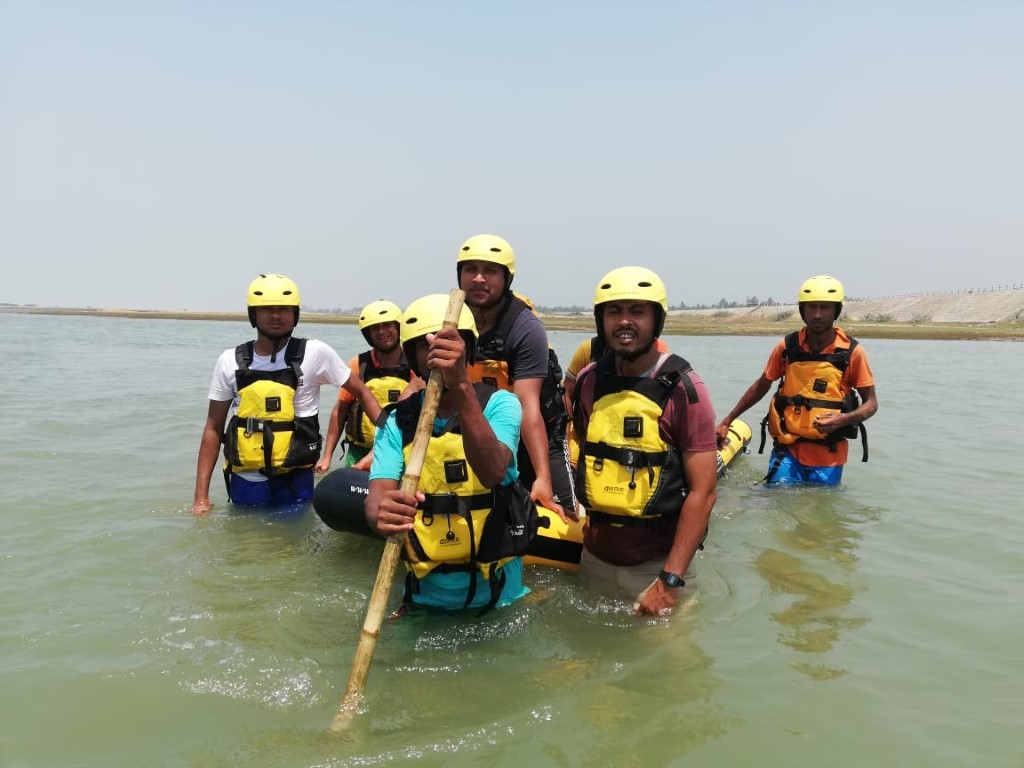
26 Jul A drowning prevented: how empowering communities saves lives
It’s early July in a rain-sodden refugee camp on the Bangladeshi border with Myanmar.
An 11-year-old Rohingya boy has spent the afternoon kicking a football around a patch of land with friends.
He looks down at his muddy clothes and then over to a nearby lake – the perfect place to wash himself off before he heads home for the evening.
Jumping into the murky waters, he soon finds himself several metres from the bank.
Suddenly, he begins to struggle. Panic sets in as he tries to keep his head above the water.
He’s drowning.
This story is all-too typical of the experiences refugees find themselves in when monsoon season floods the land surrounding the camps in which they’ve been forced to seek sanctuary.
Indeed, the same patch of water claimed three lives in the previous year.
But this time is different.
As shouts go out alerting others to the child’s struggle, five older Rohingya boys arrive on the scene. They’re equipped with throw bags containing vital life-saving equipment.
And, crucially, they’ve been trained for just this eventuality.
In a textbook example of water rescue skills, they throw out a float attached to a rope, hauling the young boy back towards the bank. He survives.
The boy’s rescuers knew exactly what to do because of training provided through MOAS – a non-profit committed to the welfare of displaced communities.
MOAS is currently working within the refugee camps in Cox’s Bazar, Bangladesh, set up to house the hundreds of thousands of Rohingya men, women and children forced to flee neighbouring Myanmar.
Paul Chamberlain, operations director for the NGO, has a background in flood rescue and operational search and rescue both at sea and on land. Along with his team, he implemented the training programme in March in an effort to counter the increased risks faced during monsoon season.
He said: “In Bangladesh, 20 per cent of the land mass floods each year. Drowning is the biggest killer of children under five.
“In any community which faces a disaster, it’s the people who live in that community who always provide the first line of response. So it makes sense to empower those people to respond safely.
“If you look at the situation in the camps, you have a potentially hazardous environment that many NGOs cannot safely operate in.
“They are not fully aware of the risks involved and often focus on their primary mission and not on the complexities associated with delivering that mission during extreme weather events.
“When you have a city of, essentially, a million people, removing that support because of flooding dangers is liable to lead to deaths.”
The water rescue training programme uses internationally recognised standards to ensure community volunteers have the know-how, practical experience and equipment to aid those caught up in flood waters, lakes and rivers.
Funded by the United Nations High Commission for Refugees (UNHCR) and the International Organization for Migration (IOM), MOAS will have trained 1,400 Rohingya volunteers before the programme’s current run comes to an end.
Paul said: “Key to the success of this, I believe, is we are working with already established groups so the dynamic of team work is already there. That means they can focus on skill acquisition and not the ‘getting to know you’ bit.”
The lessons learned from the programme are clear: empowering refugees themselves to solve localised problems is the most effective way of ensuring they can access help when they most need it.
For Paul and MOAS, the solutions found in Cox’s Bazar are both cost-effective and scaleable for any displaced communities at risk from flooding or treacherous waters.
“If you look at worldwide natural phenomena and disasters, between 1995 and 2015 there was something like 2.3 billion people affected by floods. These events are on the increase.
“What we’re doing is something that’s never been done – but we’ve already seen how effective it can be.”


